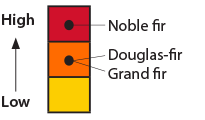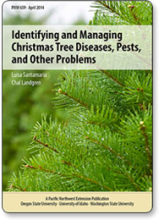Trisetacus spp., Epitrimerus pseudotsuagae, and Nelepella ednae
- Bronzing and stunting of new needles, or bronzing and curling of more developed new shoots
- Needles later turn brown, die, and drop from the shoot, leaving naked branch tips
- Localized areas in the field
- Damage caused by environmental stress
- Other mites
- Chemical and nutrient imbalances
- Look for needles at the branch tip that appear white-flecked or fuzzy when mite population is high.
- Check for clear to tan-colored eggs in clusters from late February through March.
- Check for active mites from late April through summer.
- Begin chemical control measures when new mites emerge (April to May) and again in the fall (October to November).

- High susceptibility: Noble fir
- Medium susceptibility: Grand fir, Douglas-fir

- Look for new needles bronzing and stunting: March through December
- Look for eggs: Mid-February through Mid-March
- Spray miticide (if needed) labeled for eriophyid mites: Mid-March through May, September through Mid-November


